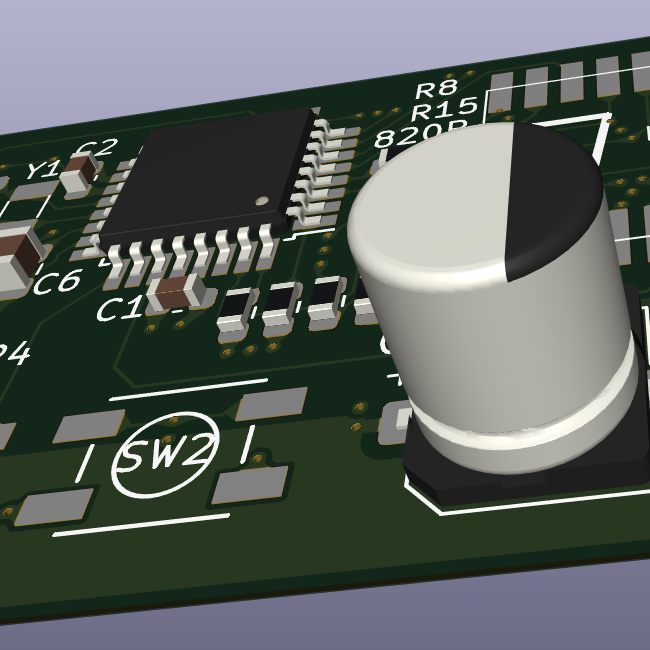

That’s like saying a bus driver’s job is to turn a steering wheel.
That’s a good analogy, I will use that.


That’s like saying a bus driver’s job is to turn a steering wheel.
That’s a good analogy, I will use that.


It is not much about the voltage level but high frequency current activity. Current can cause voltage drop on parasitic resistance and inductance of the breadboard, jumpers, connections, passive components etc. and can cause supply of the chip to be non-ideal or ripple. Your power source is a battery and not a switching power supply, so power will be cleaner, which is good. The chip also doesn’t consume high current, and its output is 32khz clock, fairly low frequency. So I wouldn’t worry so much about decoupling.


Decoupling capacitor is there to filter out hogh frequency ripples from the lower supply. It is very hard for the consumer to know the high frequency current consumption of the chip, and its effects on the chip. Therefore decoupling is something where you should always follow the datasheet recommendation. As others said, ceramic capacitor has lower series resistance and inductance, which makes it the better choice for decoupling. Follow the instructions on layout as well, which usually says that decoupling capacitor should be as close as possible to the chip and grounded well. That being said, if you are prototyping on a breadboard, series inductance of a capacitor may not be your biggest concern, as breadboard connections will have that too. You can also still try to get your circuit working with the capacitor you have while waiting for ceramic one, chances are any capacitor will work good enough.
Isn’t it the opposite? Sun is rising late, so less likely to be woken up by sun (if that’s the joke).


“Terrorism” has had a very loose definition in Turkey for years. Pretty much any anti-government activity or criticism can be labelled as such.
An emergency alert went off on my wife’s phone for a second time at 2.50, and 26 minutes later I still couldn’t fall asleep. I am also anxiously waiting for my alarm to ring any time. I don’t want to disable emergency alarms because they are important, but if they keep sending them in the middle of the night again and again at different hours they aren’t leaving me much choice.
Water drips on the way from the lake, not towards the lake.


Hold a small piece of metal (paper clip?) between solder pads with a tweezer. Heat up tip of a metal fork/spoon (Sharp edge of fork could work better) on a stove. Take it from stove and use it immediately to melt the solder on one pad (seems like there is already enough solder there). I am not sure if it would work but maybe worth trying. Heating entire fork could be hard, so maybe something with smaller metal mass could work better, like a screwdriver, nail clipper etc).


DC motors have high inductance, meaning that the current going over it will resist to change. When you turn off a pair of nmos, current will likely start flowing over the the other pair, from source to drain. Depending on the spec of your nmos, you may consider using diodes in parallel to nmos to carry this current. Obviously these diodes should be reverse biased during normal operation.


Not answering the question but if you studied in English outside of the UK it may be enough. But you need to certify that you studied in English through https://www.ecctis.com/visasandnationality . That is how I did it, and I think it is easier and can be quicker.
In my first ever programming class textbook was using Allman. Probably for this reason, it is easy for a beginner to match braces. It is a lot loss common industry to my knowledge.


If you are working in a decent workplace, you will receive lots of feedback on your code and what you do. Don’t take it personal and learn from them. Sometimes there are multiple correct answers and yours can be one of them, but each workplace, project and senior colleague has their own concerns and priorities. Sometimes feedback seems to be on a trivial mundane detail, and sometimes it really will be. If you think it is valuable feedback, learn. If you disagree, discuss. Enjoy!


As you said before power on capacitor is discharged. Right after power on capacitor is still discharged, so voltage on capacitor is zero, so reset pin has Vcc. With time capacitor gets charges and voltage across capacitor increases and reset voltage becomes closer and closer to ground, until it is ground. But it is important to consider what happens at power down too. At power down capacitor is charged. If power source becomes high impedance at power down, then reset pin will probably go down to zero in time but may take a bit time depending on what source exactly does. But if power source is connected to zero at power down reset pin will observe minus vcc and slowly go up to 0. If reset pin is sensitive it may be a good idea to protect it with a diode.

Simpsons predicted it once again.


If you knew about the birds and the bees, you would know that this wasn’t random.


Immerse yourself into technology. Become the screen.


I don’t know what it is. It just reminded me of ATMEL8051 and I wanted to share.
I don’t know. If the poster couldn’t be bothered to fact-check, why would I? It is just safer to assume that it can be misinformation.